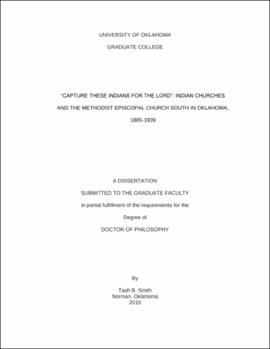| dc.contributor.advisor | Metcalf, Warren | |
| dc.creator | Smith, Tash B. | |
| dc.date.accessioned | 2019-04-27T21:26:38Z | |
| dc.date.available | 2019-04-27T21:26:38Z | |
| dc.date.issued | 2010 | |
| dc.identifier | 99198875902042 | |
| dc.identifier.uri | https://hdl.handle.net/11244/318703 | |
| dc.description.abstract | "Capture These Indians for the Lord" examines the ways that Christian Indians developed within a white-dominated church society, both from their own actions as well as from the growing indifference of white officials. Focusing on the work of the Southern Methodist Church in Oklahoma from the 1860s until the reunification of American Methodism in 1939, this study explores the roots of Methodism among the Five Tribes, who the government removed to eastern Indian Territory in the early nineteenth century, in addition to the Southern Plains Indians located at the Kiowa-Comanche-Apache Agency after the Civil War. | |
| dc.description.abstract | For nearly a century, the Southern Methodist Church operated Indian missions in Indian Territory under the explicit banner of "Christianization" and "assimilation." The Church's Indian Mission Conference (which oversaw its work in Indian Territory) remained an active and strong field, the Church liked to report, as its missionaries spread throughout the Five Tribes in the post-Civil War decades and later to the Kiowa-Comanche-Apache Agency after 1887. What made the Southern Methodist Church so effective in the nineteenth century was its reliance on native converts as ministers and translators. | |
| dc.description.abstract | Eventually, "the badge of missions" began to wear on the Indian Mission Conference even as its own Indian congregations and membership increased. The use of a native pastorate now served as a reminder of just how far removed the conference was from the rest of the nation and mainstream Church society. White officials pushed for Indian assimilation not out of a desire to convert a non-Christian population, but in order to legitimize their own standing within the National Church. The Indian Mission Conference exploited its connections to Indian missions for its own benefit and made concessions when necessary to attract Indian support for its goals, though its level of legitimacy became tied to ideas of Indian assimilation. In time, whites grew indifferent to the needs of Indian converts and changed their focus to other white communities. | |
| dc.description.abstract | Yet, in this indifference, Christian Indians found outlets for their autonomy and they found room to exist while surrounded by primarily white churches. Indian congregations were "Christian" in appearance and, therefore, a sign of missionaries' "success," even though their exact beliefs and practices might differentiate them from the mainstream of church society. In this space that they created, Christian Indians pursued Christianity to meet their own needs, often through the institutional avenues that their denomination provided. Christian Indians might organize church-sanctioned groups and congregations on an Indian-only basis in order to promote their specific needs; they might infuse their services with distinct elements of their native culture that made whites into outsiders in Indian churches; or they might push their denomination into territory typically controlled by other religious groups. These actions showed that Indians could express their autonomy within the mission process, and that they would promote Christianity in ways that appealed to Indian communities regardless of the considerations of the white-dominated Christian society. Since these events occurred within a church-approved context, white officials could tacitly condone these activities as "Christian" even if they could not completely understand them. This also demonstrated that the needs of Christian Indians sometimes ran counter to the needs of white officials, who were often forced to react when Indians expressed Christianity in ways that they were not prepared to address. | |
| dc.format.extent | 371 pages | |
| dc.format.medium | application.pdf | |
| dc.language | en_US | |
| dc.relation.requires | Adobe Acrobat Reader | |
| dc.subject | Indians of North America--Religion | |
| dc.subject | Indians of North America--History--19th century | |
| dc.subject | Indians of North America--History--20th century | |
| dc.title | "CAPTURE THESE INDIANS FOR THE LORD": INDIAN CHURCHES AND THE METHODIST EPISCOPAL CHURCH SOUTH IN OKLAHOMA, 1865-1939 | |
| dc.type | text | |
| dc.type | document | |
| dc.thesis.degree | Ph.D. | |
| ou.group | College of Arts and Sciences::Department of History | |
